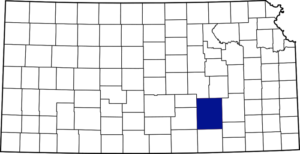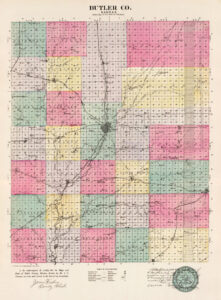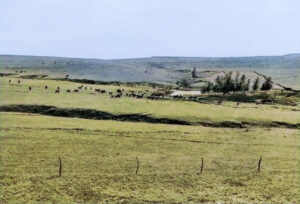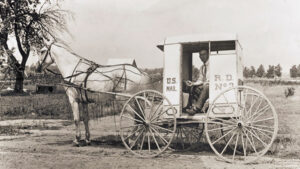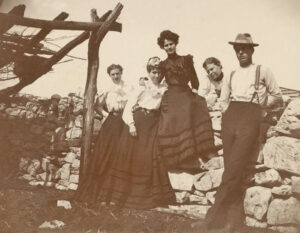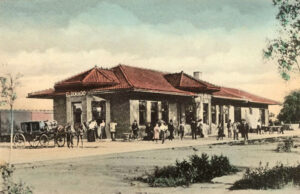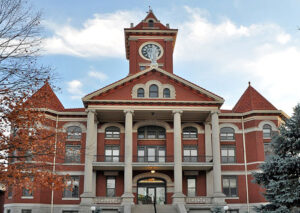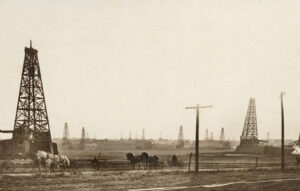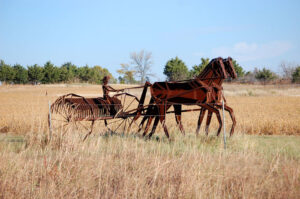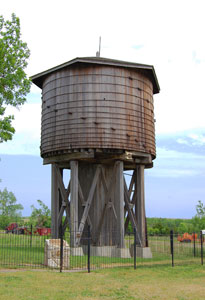Andover
Augusta
Beaumont – Semi-Ghost Town
Benton
Cassoday
Douglass
El Dorado – County Seat
Latham
Leon/Little Walnut
Potwin
Rosalia
Rose Hill
Towanda
Whitewater
One-Room, Country, & Historic Schools of Butler County
El Dorado Lake
Butler County, Kansas, in the southeastern part of the state, was one of the original counties created by the Territorial Legislature in 1855. It was named in honor of a South Carolina Senator, Andrew Butler, one of the authors of the Kansas-Nebraska Act of 1854 and a strong pro-slavery advocate. The largest county in the state by total area, its county seat is El Dorado, and its most populous city is Andover. As of the 2020 census, the county population was 67,380.
It is in the second tier of counties north of Oklahoma and the fifth west of Missouri. It is bounded on the north by Marion and Chase Counties, on the east by Greenwood and Elk, on the south by Cowley, and on the west by Sedgwick and Harvey Counties. It has an area of 1,428 square miles, larger than the state of Rhode Island.
Though it is primarily comprised of prairie, it has considerable land with a slightly rolling character. The surface in the western part is principally “bottom” land and rolling prairie. The eastern part is, in many places, broken and rough. In its early days, the river and creek bottoms comprised about one-fifth of the area and were from a mile to two miles wide. The timber belts along the streams ranged from a quarter of a mile to a mile in width, the principal varieties being oak, walnut, hickory, mulberry, sycamore, elm, and hackberry. The principal stream is the Whitewater, in the northwest part of the county, which joins the Walnut at Augusta. These two streams have several tributaries, the most important of the Whitewater being Henry, Wentworth, Bakers, Rock, and Meadow Creeks; those of the Walnut the Cole, Durechon, Satchels, Bemis, Bird, Turkey, Four Mile, Little Walnut, Eight Mile and Muddy Creeks.
Limestone was abundant, and extensive quarries were developed, from which large quantities of stone were shipped to nearby cities. Gypsum was been found in small quantities in the western part of the county. Coal was found in thin layers in some places but was never been mined extensively.
The first settlements were probably made in about 1854 by men who located along the streams and established cattle ranches and trading posts. But the first official records of settlement date back to May 1857, when William Hildebrand settled in El Dorado Township. In June of the same year, Samuel Stewart of Lawrence organized a colony to settle in the county. They followed a trail to the point where it crossed the Walnut River, where they arrived on June 15, 1857. The Osage Trail also crossed at this point. Within a short time, a town site was surveyed, and here, on the banks of the Walnut, the “land of gold” was found and named El Dorado. Among the members of this pioneer colony were William Bemis, Henry Marten, Jacob Carey, H. Bemis, William Crimble, and some ten other families. A man named Schaffer took a claim on the west bank of the Walnut River and built a cabin just north of the site of the present town of El Dorado. His claim extended across the west branch but was not entered until 1868.
At the election under the Lecompton Constitution, December 21, 1857, there is no record of any returns from Butler County, but in October 1857, Madison and Butler Counties polled 69 free-state and seven Democratic votes. On August 2, 1858, an election was held at the old El Dorado townsite on the Lecompton Constitution, and the entire vote (21) polled was cast against that infamous platform.
Lawrence was the nearest established post office when the first settlers settled in Butler County. All mail addressed to box 400 at Lawrence was taken by a hack to Emporia, where it was sent down by anyone who was passing. But a regular distributing station was established at Chelsea in 1858, with C. S. Lambdin as postmaster, and at El Dorado in 1860, with D. L. McCabe as postmaster. In 1863, mail was also brought from Cottonwood Falls.
In 1858 and 1859, it was estimated that there were about 50 actual settlers in Butler County, prominent among them being Judge Lambdin, Archibald Ellis, Judge Harrison, P. P. Johnson, George Donaldson, J.D. Connor, and James Gordy.
Butler County was organized by an act of February 11, 1859, and on April 30 of that year, the board of county supervisors met at the home of George T. Donaldson. The board consisted of P. G. Barrett, chairman, G. T. Donaldson, and I. S. White. They decided that the annual meeting should be held in Chelsea Hall, but other meetings were to be held at their residences, except for the probate clerk, who was to hold office at J. C. Lambdin’s until further notice. On June 13, 1859, the second board meeting was held, and P. G. D. Morton was appointed county auditor. The first county treasurer was C. S. Lambdin, appointed on September 19, 1859; J. C. Lambdin was the first probate judge; a man named Emmil, the first district court clerk; and John R. Lambdin was the first register of deeds. There is no record of a sheriff until 1863 when J. T. Goodall was elected, but Dr. Lewellen acted in that capacity in 1859.
The first record of a district school was in Chelsea Township. Sarah Satchel taught it. The second was in El Dorado Township in 1861, the funds for it being raised by subscription among the settlers.
During the Civil War, few new settlers came. In 1861, a company for the home defense was raised among the settlers northeast of El Dorado and placed under the command of P. G. D. Morton, but its only service consisted of capturing a wagon train of supplies on the way to the Indian Territory (Oklahoma) in violation of a military order. In the winter of 1861, the company built and occupied a fort about two miles northeast of El Dorado, but in the spring, it was disbanded, and most members joined the army at Fort Leavenworth.
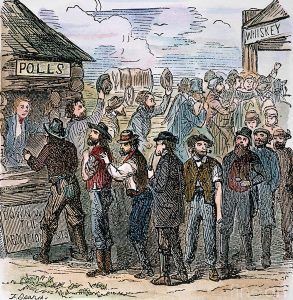
Voting in Kansas
G. T. Donaldson was elected to the state legislature in 1863 when the county consisted of but one district. In 1864, M. Vaught was appointed superintendent of schools.
The first election for the location of the county seat was held on May 21, 1864, and the old town of El Dorado was chosen, but there were no buildings suitable for county offices, and the board decided not to move there until such provision was made.
In 1867, two brothers named Moorehead moved into a cabin built by a man named Schaffer and opened the first store on a small scale, though Schaffer had kept supplies when he lived there. This is believed to be the first store on the site of the present city of El Dorado, which is located over two miles above the old town. The same year E. L. Lower built a house and opened a regular store. In March 1868, B. F. Gordy entered 160 acres of land upon which all that part of El Dorado south of Central Avenue now stands, and the town site was laid out early in the spring. A. G. Davis, William Vann, and two men named Chandler and Atwood settled in Towanda Township in July 1868; D. L. McCabe, in Rock Creek Township about the same time; Philip Carns, in July 1869, took up land in Rosalia Township, and Holland Ferguson in Fairmount Township.
During the settlement period, a few lawless characters drifted into the county. In the late 1860s and early 1870s, an outlaw band was operating around Douglas, and a vigilance committee was formed. In November 1870, four men were shot as murderers and horse thieves, the first lynching in the county.
The El Dorado Mills, one of the earliest manufacturing concerns, was built in 1870 by Wheeler and Burdett on the east bank of the Walnut River.
The first newspaper in the county was the Walnut Valley Times, first published on March 4, 1870, with Murdock and Danforth as editors and publishers. On June 1 of that year, the partnership was dissolved, and T. B. Murdock became the sole owner and continued to issue the paper until 1881, when he sold it to Alvah Sheldon.
Early in its history, the people of Butler County took a deep interest in agriculture. The Butler County Horticultural and Agricultural Society was organized in March 1872 and became one of the flourishing institutions of the county. It assisted materially in introducing new and hardy species of fruit trees that would stand the Kansas climate, and it is due largely to this society that Butler County has such fine orchards.
Another election regarding the county seat was held on May 10, 1870, when Chelsea received 256 and El Dorado 2,524. In April 1871, a contest between El Dorado and Augusta occurred with the following result: Augusta had 712 votes, El Dorado 743, and the question of a county seat was, at last, settled. For some time, most of the officers held their offices at their homes, and Dunlevy’s building was used for some public purposes. In July 1870, an effort was made to issue $25,000 worth of bonds to erect county buildings, but the proposition was voted down. On July 19, 1870, land for the courthouse was deeded to the county by C. C. and Henry Martin for the consideration of $1.00, and a contract for a courthouse was let to I.W. Branson for $3,750. The building was completed in April 1871 and used until 1875, when extensive additions were made for $8,000, which, with the erection of a jail, brought the total up to $15,000. These improvements were completed in March 1876.
The first religious services in the county were held at the Lambdin home. A Presbyterian society was organized at El Dorado, and they began building a church in 1872, but it was not completed until 1877.
The first railroad proposed across Butler County was the Kansas-Nebraska Railroad, which asked for a subscription of $150,000. This proposition was carried out when put to the people’s vote, but the panic of 1873 began, and the road building was abandoned. In May 1872, the proposition to subscribe for $150,000 worth of the bonds of the Fort Scott, Humboldt & Western Railroad was voted down, as was the next proposition of the same sort, on July 13 of the same year.
In April 1876, the Atchison, Topeka & Santa Fe Railroad Company proposed building a branch line from Cedar Point down the valley of the Walnut River to El Dorado and asked the county for a cash bonus of $3,000 a mile. The question was discussed, and in February 1877, bonds aggregating $99,500 were voted to the El Dorado & Walnut Valley Railroad. Work was immediately started, and the road was finished as far as El Dorado on July 31, 1877. In 1881, it was extended to Douglass and later to Arkansas City.
Several other roads were proposed but never built, and no further railroad building occurred until 1879, when the St. Louis, Fort Scott & Wichita Railroad began building a line east and west across the county, though bonds were not voted by the county in its behalf until 1880.
One of the early banking houses was conducted by Neal Wilkie and S. L. Shotwell, and the Bank of El Dorado was opened for business on April 5, 1880, by Edward C. Ellett and N. F. Frazier. A year later, the Butler County Bank was opened under a charter from the state.
The Walnut Valley Mills were erected in 1882.
In 1887, the Chicago, Kansas, and Nebraska Railway built a branch line north-south from Herington to Caldwell. This branch line connected Herington, Lost Springs, Lincolnville, Antelope, Marion, Aulne, Peabody, Elbing, Whitewater, Furley, Kechi, Wichita, Peck, Corbin, Wellington, Caldwell. By 1893, this branch line was incrementally built to Fort Worth, Texas. The Chicago, Kansas, and Nebraska Railway was foreclosed in 1891 and was taken over by Chicago, Rock Island, and Pacific Railway.
A new Butler County Courthouse was built in El Dorado in 1909. The red brick Romanesque Revival courthouse features a central clock tower and four octagonal corner towers, a statue of the Goddess of Justice, and a hipped roof with cross gables. It was added to the National Register of Historic Places in 2002.
In 1910, four railroad companies operated lines in Butler County. The Atchison, Topeka & Santa Fe entered on the northern boundary and ran south through El Dorado to Augusta, where a branch ran southwest to Caldwell, the main line continuing into Oklahoma; a line of the Missouri Pacific Railroad crossed the county from east to west through El Dorado, with a branch from that city to McPherson; the St. Louis and San Francisco Railroad crossed the county south of El Dorado, with a branch from Beaumont to Winfield, and the Chicago, Rock Island & Pacific Railroad crossed the northwest corner of the county.
At that time, the population of the county was 23,059. The value of field crops was 3,103,888, and of all farm products, $6,843,341. Corn led the list with a value of $923,498; hay, including alfalfa, stood second with a value of $815,246; other leading crops were Kafir corn, $764,256; oats, $322,583; Irish potatoes, $89,694. The value of animals slaughtered or sold for slaughter was $3,289,163; of poultry and eggs, $247,369; and dairy products, $199,635. There were also over 250,000 fruit trees of bearing age.
In 1915, the regional economy changed from farming and ranching to oil. On September 29, 1915, a cable tool-drilling rig owned by Wichita Natural Gas began to drill an oil well on the John Stapleton farm north of El Dorado. Within a week, a good commercial production estimated at 50 to 200 barrels a day was found at 670 feet. Stapleton No. 1 continued to drill deeper, and in December, the pay zone was reached at 2,497 feet.
This discovery became notable because it was the first well to be drilled using science and geology to pinpoint a location. Word spread quickly, and within no time, numerous other wells were being drilled. By the end of 1915, at least seven wells were completed to 660 feet.
Within weeks of striking oil on the Stapleton, representatives of oil companies such as the Carter Oil Company, an affiliate of Standard Oil; Empire Oil, an affiliate of Cities Service; and Gypsy Oil, an affiliate of Gulf Oil, began flooding into El Dorado, looking for landowners who would lease lands for oil exploration.
Butler County’s economy changed almost overnight. Lease prices for land skyrocketed, hundreds of workers were employed, and new businesses and shops were established to meet the demand.
Several company-owned towns popped up, including Oil Hill, Midian, Gordon, Browntown, and others.
By 1917, developments expanded into western, eastern, and northwestern Butler County.
This historic field, covering 34 square miles, became the largest producer among single fields in the United States. In 1918 alone, the El Dorado Field produced nearly 29 million barrels of oil. Derricks operated 24 hours a day with crews working in shifts. For those on the night shift, drugstores and other establishments were open night and day.
The town of El Dorado thrived with all this activity, and many oil companies located their offices in El Dorado. The oil strike brought the refining business to El Dorado, where the largest refinery in Kansas still operates today. By 1918, there were eight refineries in the El Dorado and Augusta areas. Other related businesses and jobs were also established, such as exploration companies, drillers, pumpers, pipelines, well-servicing businesses, and distribution outlets such as service stations.
It also influenced the course of world history by being the largest producer/supplier among single fields in the U.S. during World War I and spurred the aviation industry in Wichita by investing oil field dollars.
By 1920, Butler County’s population had nearly doubled from 23,000 in 1910 to 43,000 in 1920.
In the 1930s, production in the El Dorado oil field slowed to a more modest level, and towns like Midian and Oil Hill shrank and vanished.
History is preserved at the Kansas Oil Museum at 383 E. Central in El Dorado. Here, visitors can tour an actual pump house and two styles of operational drilling rigs, an actual shotgun-style house from Oil Hill, and view a wealth of artifacts and equipment from the early days of oil discovery. The museum boasts of housing the best collection of vintage operational oilfield equipment in the nation.
In 2010, the Keystone-Cushing Pipeline was constructed north to south through Butler County, near Potwin, Towanda, Augusta, and Douglass, with much controversy over tax exemption and environmental concerns. A pumping station named Burns was built two miles north of Potwin, and new power lines were built from a high-voltage line 0.3 mile east of De Graff.
Today, the former Skelly Refinery is now in operation as Frontier Oil and Refining. It is the largest refinery in Kansas and the only one of the eight original area refineries still in operation. Today it employs 400 workers and can process 120,000 barrels of crude oil and 15,000 barrels of natural gas liquids daily.
El Dorado’s economy is still largely based on the petroleum industry, as shown by many oil service-related businesses.
The legacy of the Butler County oil boom lives on in the legion of pumps still dotting the landscape, in the aircraft that fly overhead, and in El Dorado’s Kansas Oil Museum.
Butler County’s population of 67,380 today is higher than it has ever been.
©Kathy Alexander/Legends of Kansas, updated January 2024.
Also See:
Sources:
Blackmar, Frank W.; Kansas: A Cyclopedia of State History, Vol I; Standard Publishing Company, Chicago, IL 1912.
Butler County, Kansas
Cutler, William G; History of Kansas; A. T. Andreas, Chicago, IL, 1883.
Kansas Sampler
Perry Stratford, Jessie; Butler County’s Eighty Years – 1855-1935
Wikipedia


